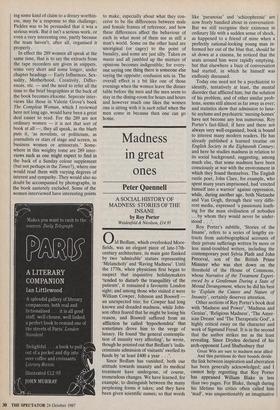Madness in great ones
Peter Quennell
A SOCIAL HISTORY OF MADNESS: STORIES OF THE INSANE by Roy Porter
Weidenfeld & Nicolson, £14.95
Old Bedlam, which overlooked Moor- fields, was an elegant piece of late-17th- century architecture, its main gate flanked by two 'admirable' statues representing `Melancholy' and 'Raving Madness'. Until the 1770s, when physicians first began to suspect that inquisitive holidaymakers `tended to disturb the tranquillity of the patients', it remained a favourite London sight; and among those who visited it were William Cowper, Johnson and Boswell an unexpected trio; for Cowper had long known and dreaded madness, while John- son often feared that he might be losing his reason, and Boswell suffered from an affliction he called 'hypochondria' that sometimes drove him to the verge of lunacy. He found 'the general contempla- tion of insanity very affecting', he wrote, though he pointed out that Bedlam's 'indis- criminate admission of visitants' swelled its funds by 'at least £400 a year . . .'.
Since Bedlam has vanished, both our attitude towards insanity and its medical treatment have undergone, of course, tremendous changes. We have learned, for example, to distinguish between the many perplexing forms it takes; and they have been given scientific names; so that words like 'paranoiac' and 'schizophrenic' are now freely bandied about in conversation. But we still recognise their existence in ordinary life with a sudden sense of shock, as happened to a friend of mine when a perfectly rational-looking young man in- formed her out of the blue that, should he sit down at a cinema, he noticed that the seats around him were rapidly emptying, but that elsewhere a buzz of conversation had started, in which he himself was endlessly discussed.
Today one need not be a psychiatrist to identify, tentatively at least, the mental disorder that afflicted him; but the solution of his problem, and of other similar prob- lems, seems still almost as far away as ever; and statistics show that admission to luna- tic asylums and psychiatric 'nursing-homes' have not become any less numerous. Roy Porter's fact-filled, if here and there not always very well-organised, book is bound to interest many modern readers. He has already published a learned treatise on English Society in the Eighteenth Century; and here he studies madness in relation to its social background, suggesting, among much else, that some madmen have been consciously at war with the environment in which they found themselves. The English rustic poet, John Clare, for example, who spent many years imprisoned, had 'erected himself into a warrior' against oppression, while, during another age, both Nietzsche and Van Gogh, through their very diffe- rent media, expressed 'a passionate loath- ing for the mass civilisation of nobodies ... by whom they would never be under- stood . .
Roy Porter's subtitle, 'Stories of the Insane', refers to a series of lengthy ex- tracts from autobiographical accounts of their private sufferings written by more or less mind-troubled writers, including the contemporary poet Sylvia Plath and John Perceval, son of the British Prime Minister who was shot down on the threshold of the House of Commons, whose Narrative of the Treatment Experi- enced by a Gentleman During a State of Mental Derangement, where he did his best to 'Explain the Causes and Nature of Insanity', certainly deserves attention.
Other sections of Roy Porter's book deal with 'Madness and Power', 'Madness and Genius', 'Religious Madness', 'The Amer- ican Dream' and 'The Therapeutic God', a highly critical essay on the character and work of Sigmund Freud. It is in the second that the author strikes me as the least revealing. Since Dryden declared of his arch-opponent Lord Shaftesbury that
Great Wits are sure to madness near allied And thin partitions do their bounds divide the link between inspiration and aberration has been generally acknowledged; and I cannot help regretting that Roy Porter has appraised William Blake in less than two pages. For Blake, though during his lifetime his critics often called him `mad', was unquestionably an imaginative
genius, who lived a steady sober life. Yet there is no doubt that he also inhabited a world of glorious make-believe, convinced that his pictorial 'visions' had a celestial origin, though they were frequently de- rived from his unconscious memory of pictures and statues he had once admired, and that his drawings of 'The Ghost of a Flea' and The Man who Built the Pyra- mids' were portraits of spectral presences that had really visited his studio, and he had observed through earthly eyes. His case needs much more extensive study. Despite the fact that he claimed he could talk to the Prophets, and 'he and his wife sat around naked in their garden recapitu- lating paradise', to label Blake 'an odd cove' seems a strangely inadequate conclusion.



















































 Previous page
Previous page